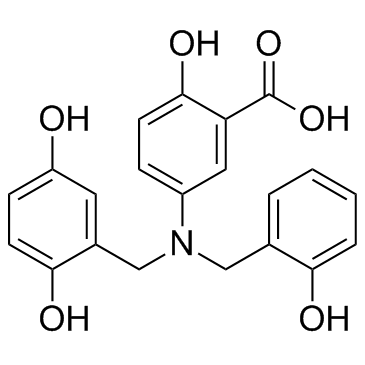125697-92-9
| Name | lavendustin a |
|---|---|
| Synonyms |
MFCD00153822
Lavendustin A 5-[(2,5-dihydroxyphenyl)methyl-[(2-hydroxyphenyl)methyl]amino]-2-hydroxybenzoic acid 5-[[(2,5-Dihydroxyphenyl)methyl][(2-hydroxyphenyl)methyl]amino]-2-hydroxybenzoic acid |
| Description | Lavendustin A (RG-14355), isolated from Streptomyces Griseolavendus, is a potent, specific and ATP-competitive inhibitor of tyrosine kinase, with an IC50 of 11 ng/mL for EGFR-associated tyrosine kinase[1]. It suppresses VEGF-induced angiogenesis and blocks the induction of LTPGABA-A[2][3]. |
|---|---|
| Related Catalog | |
| Target |
IC50: 11 ng/mL (EGFR-associated tyrosine kinase)[1]. |
| References |
| Boiling Point | 741.7ºC at 760 mmHg |
|---|---|
| Melting Point | 205-215 °C |
| Molecular Formula | C21H19NO6 |
| Molecular Weight | 381.37900 |
| Flash Point | 402.4ºC |
| Exact Mass | 381.12100 |
| PSA | 121.46000 |
| LogP | 3.41400 |
| Appearance | crystalline |
| Vapour Pressure | 4.23E-23mmHg at 25°C |
| Storage condition | −20°C |
| Stability | Moisture Sensitive: Hygroscopic |
| Water Solubility | DMSO: soluble |
| Hazard Codes | Xi |
|---|---|
| Risk Phrases | R36/37/38 |
| Safety Phrases | S37/39-S26 |
| WGK Germany | 3 |
